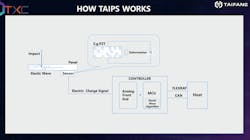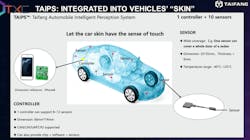This video appeared in Electronic Design and has been published here with permission.
What you’ll learn:
- What is elastic-wave touch sensing?
- How does elastic-wave touch sensing compare to capacitive touch sensing?
- How Taifang is using TAIPS on cars.
Capacitive touch sensing is ubiquitous, but it’s only one of many technologies that can be used to determine when someone or something has made contact. Though capacitive touch offers many advantages, it has limitations as well. For example, it’s unable to work in some harsh environments, or the type of touch being detected can be more challenging, such as when a person is wearing a glove.
Some instances of capacitive touch sensing address these challenges. However, alternatives like elastic-wave technology offer many advantages, including the ability to detect the amount of pressure involved in touching a surface.
I talked with Taifang’s Bob Yang about their elastic-wave technology and the Taifang Automobile Intelligent Perception System (TAIPS) (see the video above). Unlike touch sensing for a smartphone screen, TAIPS is designed to address contact with almost any surface on a car.
Elastic-wave sensing technology uses a sensor attached to a surface (Fig. 1). This can be used to detect the amount of pressure and the position of the contact. For devices such as touchscreens, it can detect gestures.
The system architecture is similar to a capacitive touch system with a controller that interfaces with the sensors. The main difference is that the elastic-wave technology is passive with the sensor detecting the pressure waves. The controller determines where and how hard the contact is based on the sensor input.
The Taifang Automobile Intelligent Perception System (TAIPS) isn’t set up to detect touch gestures on the surface of a car, but it uses the same elastic-wave sensing technology to determine when something comes in contact with a car, such as a collision (Fig. 2).
Sensors would be placed on surfaces all around the car, from doors to bumpers. The technology can determine the location and pressure involved. One use case would allow a car rental company to determine when damage might have occurred from a major collision to a minor scrape.
Elastic-wave technology works on detecting contact pressure from some object with a surface. This includes any type of object, from a person wearing a wet glove to an exposed finger. The ability to determine where the contact is made enables a system to detect gestures and movement. The accuracy, latency, and pressure sensitivity varies depending on the surface, sensor, and controller.

